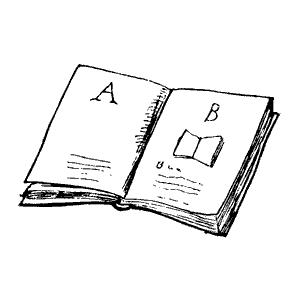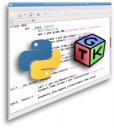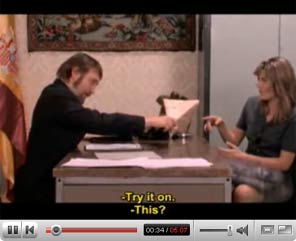This is the latest xkcd comic strip. Yay!
Entrevista con Richard Stallman
En Versus blog se publica una entrevista a Richard Stallman, personaje fundador del movimiento del software libre, en el que, como siempre, muestra su interesante y controvertida personalidad, sin dar puntada sin hilo.
Ya que se publica bajo licencia Creative Commons, Share Alike, la reproduzco a continuación para tenerla a mano:
Continuar leyendo «Entrevista con Richard Stallman»
¿Es usted feminista?
Hace un tiempo que no echaba un vistazo al estimulante blog de Montse. Recomiendo la visita periódica a su sitio (también a mujeres en red) para refrescar y oxigenar la mente.
Desde allà llegué al blog de Lourdes Muñoz, y a esta cita
¿Está usted a favor de la paz, de la redistribución de la riqueza? ¿Prefiere las sociedades democráticas? ¿Le gustarÃa dedicar menos tiempo al trabajo y ganarlo para el ocio, los hijos, la pareja? ¿Cree en los derechos humanos? ¿Rechaza la violencia? ¿SÃ? Usted es feminista. Porque esos principios son los que han inspirado siempre a las mujeres aliadas bajo ese movimiento, largo tiempo estigmatizado.
Corresponde al primer párrafo de la crónica de Carmen Morán en El PaÃs sobre el III Encuentro de Mujeres LÃderes Iberoamericanas. El encuentro se celebró en Madrid del 1 al 4 de octubre.
Walking on air – Toledo desde el tejado
One of the things I love of being an architect is the opportunity to see and enjoy unusual and even hidden views…
Last week I visited Toledo, as part of an ongoing contract, where I’m doing the structural engineering evaluation and consultancy for the rehabilitation of an old building. This building is very interesting, as some of its parts date back to the XI century, with some additions from the XV century, and minor ones later on. Besides that, it’s structure is a frankenstein like mix of masonry walls, timber frames, wooden columns and beams, earth walls and even some recent steel parts.
Useful Thunderbird and Firefox addons
List of some nice Thunderbird and Firefox addons I currently use, both on GNU/Linux and Windows:
Firefox:
- Firebug, Yslow, Colorzilla, JSView:
Powerful addons to debug and help into the development of websites and webapps - Minimize to Tray Plus, Remember mismatched domains, Download statusbar, Bookmark Duplicate Detector
Convenience addons - Scrapbook
Locally store web contents
Thunderbird:
- External editor:
to be able to warmly use gvim to compose messages 🙂 - SyncMab:
to synchronize (export/import) the address book. - Quote colors:
Colors paragraphs depending on quoting level. Very useful for mailing list reading. - Colored Diffs:
Colors inline diffs. Very useful for mailing list reading. - Sync on arrival:Get IMAP mail as soon as a new message notification arrives
- Copy sent to currentPut reply as child message
- Minimize to tray Plus, Remember mismatched domains:
Convenience addons
Punto y Raya Festival 0.2
El primer fin de semana de septiembre nos pasamos Reyes y yo por el Punto y Raya Festival 0.2 en La casa encendida.
Tras ese tÃtulo tan sugerente, la organización añadÃa en la convocatoria del festival:
Este festival explora la sÃntesis máxima de la dualidad forma·movimiento en diversas esferas artÃsticas. Gracias a la simplicidad de la consigna utiliza la materia prima de la abstracción humana para revelar los logros y las limitaciones de nuestras formas de representación.
El punto·raya es el grano mÃnimo sobre el que se construye nuestro universo y el entendimiento que de él tenemos; es la identificación primaria de lo que existe; la esencia de lo que no es materia pero constituye la materia, de lo que no es perceptible pero permite el reconocimiento de lo que sà lo es.
Pero en la dimensión simbólica el punto·raya deja de ser un fin en sà mismo para representar diversas actuaciones de la mente humana
El contenido del festival giraba entorno a la creación audiovisual de contenido y estructura abstracta. El programa, además del maratón de obras a concurso, incluÃa una retrospectiva (con obras de los años 20 a nuestros dÃas), un taller de creación (del que pudimos ver las obras resultantes), y un par de conferencias (a cargo de AgustÃn GarcÃa Calvo y de José Antonio Millán).
Disfrutamos mucho del festival, a pesar de no haber podido asistir a todas las actividades, y esperamos que se repita en años venideros.
Continuar leyendo «Punto y Raya Festival 0.2»
Some great laughs
Today my cousin Manuel sent me a youtube link pointing to a sketch for an humoristic TV show he and some other talented people are creating. The gags reminds me of those from Monty Python. Bright and acid, criticizing some of our worst defects as a society by looking at them through a surreal glass. It really made me laugh and think.
Even if I’m clearly biased in favor of anything this cousin creates, he, and his team, have already showed their talent before approaching this new challenge in a number of theater and TV plays and scripts, besides his role as theater and short film director. I hope they continue to nurture and develop their artistic vein (and a TV channel buys them the sketches).
Sólo lectura
A través de un artÃculo de El PAÃS se puede leer en una entrevista a Lawrence Lessig:
la cultura en el siglo XIX era «regrabable», ya que los autores creaban apoyándose en las ideas de otros. El siglo XX es de «sólo lectura», porque la extensión del copyright -en la Constitución estadounidense de 1787 duraba 17 años; ahora, se acerca a los 200- y el hecho de que las herramientas creativas estén en manos de unos pocos convierte a los creadores en consumidores pasivos o en delincuentes que violan la propiedad intelectual
On how to argue
 Here’s an interesting cite dealing with how to argue constructively. These words are attributed to the mathematical psychologist Anatol Rapoport and I discovered them thanks to the brilliant Bryan O’Sullivan blog, of Mercurial fame:
Here’s an interesting cite dealing with how to argue constructively. These words are attributed to the mathematical psychologist Anatol Rapoport and I discovered them thanks to the brilliant Bryan O’Sullivan blog, of Mercurial fame:
Serious argument depends on mutual respect, and this is often hard to engender when disagreements turn vehement.
The social psychologist and game theorist Anatol Rapoport (creator of the winning Tit-for-Tat strategy in Robert Axelrod’s legendary prisoner’s dilemma tournament) once promulgated a list of rules for how to write a successful critical commentary on an opponent’s work.
First, he said, you must attempt to re-express your opponent’s position so clearly, vividly and fairly that your opponent says “Thanks, I wish I’d thought of putting it that way.†Then, you should list any points of agreement (especially if they are not matters of general or widespread agreement), and third, you should mention anything you have learned from your opponent. Only then are you permitted to say so much as a word of rebuttal or criticism. I have found this a salutary discipline to follow–or, since it is challenging, to attempt to follow. When it succeeds, the results are gratifying: your opponent is in a mood to be enlightened and eagerly attentive.
It looks like a good advice to keep oneself honest and being able to learn as much as you can from others’ points of view.
Update: two interesting blog posts on the topic are how to win friends and influence people, by D.Berkholz and how to disagree, by P.Graham
Yay Planet Gnome!
 This is my first post after being added to the planet.gnome.org feed, so, thanks to Jeff Waugh for it and to Alberto Ruiz for putting his hackergotchi skills to my service! :).
This is my first post after being added to the planet.gnome.org feed, so, thanks to Jeff Waugh for it and to Alberto Ruiz for putting his hackergotchi skills to my service! :).
For those that don’t use to hang on the #pygtk IRC channel, I’ll briefly introduce myself.
My GNOME related activities are mainly tied to the PyGTK project the Python bindings to GTK+, working mostly on keeping the site up-to-date, and give some help on IRC, besides contributing translations and documentation to the project. Thanks to Johan, Gustavo, Kiko and Finlay for helping to get into it and make PyGTK rock.
Besides that, I’m a young architect living in Madrid which some years ago got deeply in love with free software as a hobbyist programmer who was eager to learn.
As Alberto Ruiz already posted and you may already know, we are trying to refactor a bit the www.pygtk.org website, so as to make it easier to find and navigate its contents and keep a bit more focused.
We’d like to help new contributors to get involved in keeping the project rolling. So these are some of the tasks we’d like to slowly achieve, and, as always, any help is much appreciated:
- Choose the right words for the website key navigational categories.
The key points here, IMHO, are using simple words, avoid technical terms, being descriptive but terse, concise and precise. Suggestions are welcome :).
Ideally, we’d like to simplify it, dividing the information into the ‘Know about PyGTK’, ‘Get PyGTK’, ‘Learn’, ‘Participate’ categories, and finally use them as the four entry points for the site contents, similarly to what the RoR folks are doing.
- Publish the PyGTK FAQ on HTML and PDF formats.
Now that the PyGTK FAQ lives in the gnome.org wiki, we’d like to have scripts to fetch those contents and generate static HTML and PDF versions from them. It would serve also as a backup measure.
It’s already possible to get a docbook version from MoinMoin pages, and a docbook to HTML and PDF is already in place for the PyGTK reference and PyGTK tutorial, but it has not been tested for this purpose, and we still miss a (python) script to fetch the FAQ pages and drive the static HTML and PDF generation.
- Get a small screenshot (200x150px) for each of the apps in the PyGTK application list.
This is all about writing GUI apps, but we still don’t show what they look like!.
- Take screenshots for our the introductory pages.
Besides explaining what PyGTK can do, we should show an attractive bunch of PyGTK apps running on various platforms (win32, OSX and other less common platform screenshots are specially welcome), as being multiplatform, the easy to take language and powerful toolkit are PyGTK’s strong points.
- Build and document how to create pygtk installers for the win32 platform
Most people using the website to get PyGTK are using that platform, as ,on GNU/Linux, distros do a great job and interpreted or compiled languages are equally hard to install, but the problem gets harder on platforms without a sensible packaging system that almost exclusively rely on unmanaged installation of disperse binaries. An this last is what Woe32, as the gettext crew calls it, is doing.
Alberto is doing a incredibly great and superb job to achieve easy distribution of PyGTK (and GTK+) apps, but further help would be very welcome. Work out a gtk+pygtk+py2exe toolchain is something that could be interestng.
- Write/collect PyGTK articles to cover all skill levels.
IMHO, we excel in covering basic and advanced skills, but we lack intermediate level documentation. There’s not too much information about application design patterns, model/presentation decoupling, how to write custom widgets or extending GTK+/Gnome using PyGTK… Probably these are hard to explain, as they’re not very detailed or very general concepts, but a mix of subtle criteria and making it all fit, but we shouldn’t avoid trying to get them explained. Some of the articles in the Gnome Journal were great in that respect, and the applications list tries to fill this gap showing examples that may help understand how other programmers do it.
If you feel like giving a shot to any of these, just show up on the #pygtk IRC channel on gimpnet and introduce yourself :).


